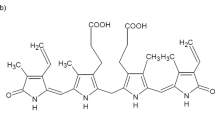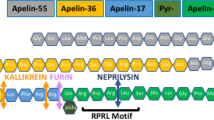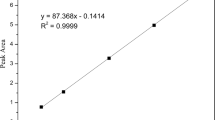Abstract
Serum transthyretin has several isoforms, most of which are caused by disulfide linkage with cysteine residue at position 10. We found an ion peak 80 D larger than unmodified transthyretin by electrospray ionization mass spectrometry and assigned it to S- sulfonated transthyretin. The peak height was <2% of total transthyretin in control sera from more than 200 individuals including infants. Transthyretin from a patient with molybdenum cofactor deficiency was analyzed, and the peak was prominent, higher than 85% of total transthyretin. In patients with this disease, the presence of elevated levels of sulfite leads to the formation of S-sulfonated cysteine. The peak can be used as a diagnostic marker for molybdenum cofactor deficiency, although more sera from patients with this disease should be tested.
Similar content being viewed by others
Main
The modern soft ionization techniques of mass spectrometry (MS) offer a simple and effective method of detecting and characterizing variant proteins by using intact molecules (1). Detection and quantification of various forms of posttranslationally modified proteins may be another promising use for MS. We first reported the method of detecting variant serum TTR by ESIMS using intact molecules (2), and the procedure has contributed to the diagnosis and clinical research of familial amyloidotic polyneuropathy, which is caused by variant TTR (3–7). Several peaks of modified forms of TTR were observed in fresh preparations of normal plasma (2). Most of the modified forms were TTR bound with thiol compounds to a cysteine residue at position 10. The thiol compounds were cysteine, cysteinylglycine, glutathione, and hydrogen sulfite (HSO3−) (3). An increased level of S- sulfonated TTR was anticipated in sera from patients with MCD, because molybdenum cofactor is the obligate activator of sulfite oxidase: defects in the biosynthesis of the cofactor impair sulfite oxidase activity, and the accumulated sulfite reacts with cysteine and cysteine residues in proteins.
METHODS
Specimens.
Two hundred ten sera from control individuals including infants and serum from a 2-y-old male patient with MCD were analyzed. The patient was born after an uncomplicated term pregnancy and delivery. At the age of 2 d, he was found to have fever and opisthotonus. Because spikes were found by electroencephalography, he was given anticonvulsants. Subsequently, he developed severe psychomotor retardation. At the age of 5 mo, incarceration of inguinal herniation occurred. At the age of 1 y, tonic clonic seizures and myoclonus occurred. At the age of 1 y 10 mo, he was found to have very low amounts of uric acid, less than 6 μmol/L (reference value 136–349), and subluxation of the lenses. Urine metabolites measured twice at age 27 and 32 mo were as follows: testing for sulfite with dipsticks positive, thiosulfate 0.1, 36 μmol/mmol creatinine (2–6), xanthine 536, 1897 (16–40), hypoxanthine 28, 782 (10–38), S-sulfocysteine 157, 539 (18–66), and taurine 28, 1205 (22–188). From these data, he was diagnosed as having MCD syndrome. He died of pneumonia and sepsis at the age of 2 y 10 mo. Informed consent for analysis of the patient's serum was obtained from the parents.
Sample preparation.
Serum TTR was analyzed by two-dimensional liquid chromatography/ESIMS as previously described (3). In brief, test serum (10 μL) was treated with blue gel (100 μL) (Bio-Rad, CA) to remove albumin by using an ultra-free molecular cut centrifugal 0.45-μm filter unit (Millipore, Bedford, MA). The gel was washed with 40 μL of distilled water twice, and the pooled filtrate (100 μL) was applied to an on-line tandemly connected two-dimensional liquid chromatography/ESIMS. The first column was a strong anion exchanger (PL-SAX, 1000 Å, 4.6 × 50 mm, 8 μm, Michrom BioResource, Pleasanton, CA), and the second was a reversed-phase styrene (PLRP-S, 1000 Å, 0.5 × 50 mm, 8 μm, Michrom BioResource). The eluate corresponding to TTR from the first column was introduced to the protein trap cartridge and then to the second column by switching the valve. After the remaining salt had been removed by washing with solvent A of the second column for 5 min, the second chromatography was developed by gradient increase of solvent, and the eluate was introduced directly to the ESI mass spectrometer, TSQ7000 (Thermo Quest, San Jose, CA).
For reduction of serum, 2 M cysteine solution in water was added to serum at 1 M final concentration.
RESULTS
Deconvoluted ESIMS spectra of TTR from a control 2-y-old male infant and from the infant with MCD are shown in Figure 1. Several peaks of modified forms of TTR are observed in the spectrum from the control (Fig. 1A), and the profile was essentially the same as we described previously for more than 200 control individuals including infants (2–4). The assignment of each peak is shown in the Figure legend. The spectrum of TTR from the patient with MCD (Fig. 1B) showed a prominent peak marked by a rectangle at 80 D larger than unmodified TTR, peak a. The peak is S- sulfonated TTR, which was confirmed by us (3) and others (5). The peak of unmodified TTR marked as peak a in the spectrum was relatively low, and the ratio of the peak height of TTR S-sulfonated to that of free TTR was approximately 15:85. When the serum was reduced, TTR S-sulfonated changed to unmodified TTR (Fig. 1C).
Deconvoluted ESIMS spectra of TTR from a normal infant (A) and from a patient with MCD (B, C). (A) and (B) Not reduced; (C) reduced. a, Free TTR;b, TTR conjugated with cysteine;c, TTR conjugated with cysteinylglycine;d, TTR conjugated with glutathione; □, TTR S-sulfonated; ★, modified TTR in which side chain of cysteine residue is cleaved; ▵, TTR in which glycine1-proline 2 is cleaved. The assignment of each peak was discussed in a previous paper (3). ♦, Observed molecular mass corresponded to TTR in which methionine is oxidized to methionine sulfone.
DISCUSSION
The prominent peak in the ESIMS spectrum obtained with serum from a patient with MCD was 80 D larger than free normal TTR. In patients with this disease, sulfate production is decreased and sulfite accumulates. The presence of elevated levels of sulfite leads to accumulation of S-sulfocysteine, formed by a direct reaction of sulfite with cysteine (8). TTR contains a single free cysteine at position 10. The formation of protein S-sulfonated compounds (RS-SO3−) in the albumin and fibronectin of several animal species exposed to sulfur dioxide or to sulfite/hydrogen sulfite has been reported (9).
In sera from control individuals (more than 200 samples), S- sulfonated TTR was a minor component (<2%). The peak of S- sulfonated TTR was characteristic in the serum from the patient with MCD, and it was easily distinguishable from controls from various sources. This peak is expected to be useful as a diagnostic marker. A European survey group suggested that the disease is more common than has been supposed and that some cases may be overlooked because of a lack of awareness of the disease and a lack of reliable screening tests (10). Although more samples from patients with the disease should be analyzed, we propose that the detection of the sulfite adduct by MS is the practical method of diagnosing the disease, and this method may improve recognition of the disease. Also, by another MS method, i.e. matrix-assisted laser desorption ionization/time-of-flight MS (Voyager, Perceptive, CA), S- sulfonated TTR peak was clearly observed in addition to unmodified TTR in the patient's serum (data not shown).
Abbreviations
- TTR:
-
transthyretin
- MCD:
-
molybdenum cofactor deficiency
- ESIMS:
-
electrospray ionization mass spectrometry
References
Shackleton CHL, Falick AM, Green BN, Witkowska HE 1991 Electrospray mass spectrometry in the clinical diagnosis of variant hemoglobins. J Chromatogr 562: 175–190.
Kishikawa M, Nakanishi T, Miyazaki A, Shimizu A, Nakazato M, Kangawa K, Matsuo H 1996 Simple detection of abnormal serum transthyretin from patients with familial amyloidotic polyneuropathy by high-performance liquid chromatography/electrospray ionization mass spectrometry using material precipitated with specific antiserum. J Mass Spectrom 31: 112–114.
Kishikawa M, Nakanishi T, Miyazaki A, Shimizu A 1999 A simple and reliable method of detecting variant transthyretins by multidimensional liquid chromatography coupled to electrospray ionization mass spectrometry. Amyloid 6: 48–53.
Kishikawa M, Nakanishi T, Miyazaki A, Hatanaka M, Shimizu A, Tamoto S, Ohsawa N, Hayashi H, Kanai M 1998 A new nonamyloid transthyretin variant, [G101S], detected by electrospray ionization/mass spectrometry. Hum Mutat 12: 363
Theberge R, Connors L, Skinner M, Skare J, Costello CE 1999 Characterization of transthyretin mutants from serum using immunoprecipitation, HPLC/electrospray ionization and matrix-assisted laser desorption/ionization mass spectrometry. Anal Chem 71: 452–459.
Ando Y, Ohlsson PI, Suhr OB, Nyhlin N, Yamashita T, Holmgren G, Danielsson A, Sandgren O, Uchino M, Ando M 1996 A new simple and rapid screening method for variant transthyretin-related amyloidosis. Biochem Biophys Res Commun 228: 480–483.
Ikeda S, Tokuda T, Nakamura A, Ueno I, Taketomi T, Yanagisawa N, Li YF 1997 Transthyretin Met30 familial amyloid polyneuropathy in China. Amyloid 4: 104–107.
Johnson JL, Wadman SK 1995 Molybdenum cofactor deficiency and isolated sulfite oxidase deficiency. In: Scriver CR, Baudet AL, Sly WS, Valle D (eds) The Metabolic and Molecular Bases of Inherited Disease, 7th Ed, Vol II. McGraw Hill, 2271–2283.
Menzel DB, Keller DA, Leung KH 1986 Covalent reactions in the toxicity of SO2 and sulfite. Adv Exp Med Biol 197: 477–492.
Simmonds HA, Hoffmann GF, Perignon JL, Micheli V, Gennip AH 1999 Diagnosis of molybdenum cofactor deficiency. Lancet 353: 675–676.
Acknowledgements
The authors thank Drs. Satoshi Sumi and Kiyoshi Kidouchi (Department of Pediatrics, Nagoya City University School of Medicine) for the analyses of xanthine and hypoxanthine.
Author information
Authors and Affiliations
Additional information
Supported by a 1998–2000 grant-in-aid for exploratory research (to M.K.) from the Ministry of Education, Science, Sports, and Culture of Japan.
Rights and permissions
About this article
Cite this article
Kishikawa, M., Nakanishi, T., Shimizu, A. et al. Detection by Mass Spectrometry of Highly Increased Amount of S- Sulfonated Transthyretin in Serum from a Patient with Molybdenum Cofactor Deficiency. Pediatr Res 47, 492–494 (2000). https://doi.org/10.1203/00006450-200004000-00013
Received:
Accepted:
Issue Date:
DOI: https://doi.org/10.1203/00006450-200004000-00013




